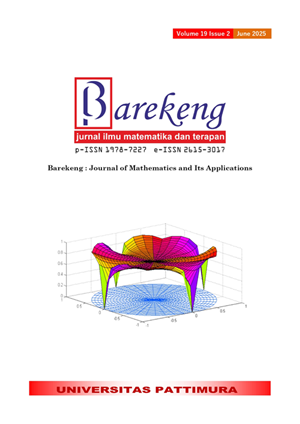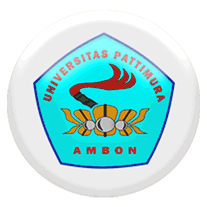STABILITY ANALYSIS OF A MATHEMATICAL MODEL OF RABIES SPREAD WITH VACCINATION IN HUMAN AND DOG POPULATIONS, INCLUDING AWARE AND UNAWARE EXPOSED SUBPOPULATIONS
Abstract
Rabies is a zoonotic disease that causes progressive and fatal inflammation of the brain and spinal cord, which can be prevented by vaccination. This study aims to analyze the stability of a mathematical model of rabies disease spread with vaccination in human and dog populations in Maluku Province. The model uses a system of ordinary differential equations that separates the human population into six subpopulations (6 variables) and the dog population into three subpopulations (3 variables). The new variables are unaware subpopulations that we divide from aware subpopulations. The results showed that disease-free and endemic equilibrium points could be achieved, and the stability of these equilibrium points was analyzed using basic reproduction numbers Both disease-free and endemic equilibrium points are locally asymptotically stable. The Numerical simulations were also conducted to determine the characteristics of each subpopulation. This study was to provide better insight into controlling the spread of rabies in Maluku Province and it can be used as a reference in developing mathematical models for other infectious diseases.
Downloads
References
K. Hampson dkk., “ESTIMATING THE GLOBAL BURDEN OF ENDEMIC CANINE RABIES,” PLoS Negl Trop Dis, vol. 9, no. 4, 2015, doi: 10.1371/journal.pntd.0003709.
C. E. Rupprecht, C. A. Hanlon, dan T. Hemachudha, “RABIES RE-EXAMINED,” 2002. doi: 10.1016/S1473-3099(02)00287-6.
S. Cleaveland, M. Kaare, D. Knobel, dan M. K. Laurenson, “CANINE VACCINATION-PROVIDING BROADER BENEFITS FOR DISEASE CONTROL,” Vet Microbiol, vol. 117, no. 1, 2006, doi: 10.1016/j.vetmic.2006.04.009.
N. T. Sapulette, Y. A. Lesnussa, dan M. E. Rijoly, “DYNAMICS OF A SIRV MODEL FOR THE SPREAD OF COVID-19 IN MALUKU PROVINCE,” BAREKENG: Jurnal Ilmu Matematika dan Terapan, vol. 17, no. 3, hlm. 1673–1684, Sep 2023, doi: 10.30598/barekengvol17iss3pp1673-1684.
A. R. Fooks dan A. C. Jackson, RABIES: SCIENTIFIC BASIS OF THE DISEASE AND ITS MANAGEMENT, FOURTH EDITION. 2020. doi: 10.1016/C2018-0-04330-3.
A. H. Manuputty, Y. A. Lesnussa, dan Z. A. Leleury, “STABILITY ANALYSIS OF PNEUMONIA MATHEMATIC MODEL WITH PREVENTION USING VACCINES AND TREATMENT,” dalam AIP Conference Proceedings, 2021. doi: 10.1063/5.0059474.
W. F. Johannis, Z. A. Leleury, dan Y. A. Lesnussa, “ANALYSIS AND SIMULATION OF MATHEMATICAL MODEL FOR THE SPREAD OF TUBERCULOSIS USE SEIT TYPE WITH DOTS STRATEGY,” dalam AIP Conference Proceedings, 2021. doi: 10.1063/5.0059489.
A. R. Fooks, A. C. Banyard, D. L. Horton, N. Johnson, L. M. McElhinney, dan A. C. Jackson, “CURRENT STATUS OF RABIES AND PROSPECTS FOR ELIMINATION,” 2014. doi: 10.1016/S0140-6736(13)62707-5.
M. J. Warrell dan D. A. Warrell, “RABIES AND OTHER LYSSAVIRUS DISEASES,” dalam Lancet, 2004. doi: 10.1016/S0140-6736(04)15792-9.
World Health Organisation, “WHO EXPERT CONSULTATION ON RABIES - FIRST REPORT,” WHO Technical report series 931, 2004.
D. L. Knobel dkk., “RE-EVALUATING THE BURDEN OF RABIES IN AFRICA AND ASIA,” Bull World Health Organ, vol. 83, no. 5, 2005, doi: /S0042-96862005000500012.
World Health Organization, “WHO EXPERT CONSULTATION ON RABIES. Second report.,” World Health Organ Tech Rep Ser, no. 982, 2013.
WHO Global Health Observatory, “RABIES DATA AND STATISTICS.”
Kementerian kesehatan Indonesia, “RABIES OUTBREAK REPORT.”
D. P. Winn, “MENYELIDIKI ASAL MUASAL DAN PENGENDALIAN WABAH RABIES DI INDONESIA [INVESTIGATING THE ORIGIN AND CONTROL OF RABIES OUTBREAKS IN INDONESIA] Retrieved from Global Alliance for Rabies Control: .”
K. Hampson, J. Dushoff, J. Bingham, G. Brückner, Y. H. Ali, dan A. Dobson, “SYNCHRONOUS CYCLES OF DOMESTIC DOG RABIES IN SUB-SAHARAN AFRICA AND THE IMPACT OF CONTROL EFFORTS,” Proc Natl Acad Sci U S A, vol. 104, no. 18, 2007, doi: 10.1073/pnas.0609122104.
U. Kayali, R. Mindekem, G. Hutton, A. G. Ndoutamia, dan J. Zinsstag, “COST-DESCRIPTION OF A PILOT PARENTERAL VACCINATION CAMPAIGN AGAINST RABIES IN DOGS IN N’DJAMÉNA, CHAD,” Tropical Medicine and International Health, vol. 11, no. 7, 2006, doi: 10.1111/j.1365-3156.2006.01663.x.
L. B. Kunwar dan V. S. Verma, “MATHEMATICAL ANALYSIS OF RABIES TRANSMISSION DYNAMICS IN NEPAL.”
M. Chapwanya, M.-S. Lubuma, dan Y. A. Terefe, “ANALYSIS AND DYNAMICALLY CONSISTENT NONSTANDARD DISCRETIZATION FOR A RABIES MODEL IN HUMANS AND DOGS.”
O. C. Eze, G. E. Mbah, D. U. Nnaji, dan N. E. Onyiaji, “MATHEMATICAL MODELING OF TRANSMISSION DYNAMICS OF RABIES VIRUS,” International Journal of Mathematics Trends and Technology, vol. 66, no. 7, hlm. 40–64, Jul 2020, doi: 10.14445/22315373/ijmtt-v66i7p506.
S. Ruan, “MODELING THE TRANSMISSION DYNAMICS AND CONTROL OF RABIES IN CHINA,” 1 April 2017, Elsevier Inc. doi: 10.1016/j.mbs.2017.02.005.
Dinas Kesehatan Provinsi Maluku, “LAPORAN TAHUNAN KASUS GIGITAN HEWAN PENULAR RABIES (GHPR) PROVINSI MALUKU TAHUN 2022,” [Annual Report on Rabies Bite Cases (GHPR) of Maluku Province in 2022"] 2023.
Dinas Kesehatan Provinsi Maluku, “LAPORAN TAHUNAN KASUS GIGITAN HEWAN PENULAR RABIES (GHPR) PROVINSI MALUKU TAHUN 2021,” ["Annual Report on Rabies Bite Cases (GHPR) of Maluku Province in 2021"] 2022.
Badan Pusat Statistik Provinsi Maluku, “JUMLAH PENDUDUK MENURUT KABUPATEN/KOTA DI MALUKU (JIWA), 2022-2024,” ["Population by Regency/City in Maluku (Population), 2022-2024"] 2024.
Badan Pusat Statistik Provinsi Maluku, “ANGKA HARAPAN HIDUP (AHH) SAAT LAHIR TAHUN 2022,” ["Life Expectancy at Birth in 2022"] 2023.
S. Abdulmajid dan A. S. Hassan, “ANALYSIS OF TIME DELAYED RABIES MODEL IN HUMAN AND DOG POPULATIONS WITH CONTROLS,” Afrika Matematika, vol. 32, no. 5–6, hlm. 1067–1085, Sep 2021, doi: 10.1007/s13370-021-00882-w.
Copyright (c) 2025 Maria Engeline Sahusilawane, Venn Yan Ishak Ilwaru, Yopi Andry Lesnussa, Lazarus Kalvein Beay, Mayowa Micheal Ojo, Vynska Amalia Permadi, Olumuyiwa James Peter

This work is licensed under a Creative Commons Attribution-ShareAlike 4.0 International License.
Authors who publish with this Journal agree to the following terms:
- Author retain copyright and grant the journal right of first publication with the work simultaneously licensed under a creative commons attribution license that allow others to share the work within an acknowledgement of the work’s authorship and initial publication of this journal.
- Authors are able to enter into separate, additional contractual arrangement for the non-exclusive distribution of the journal’s published version of the work (e.g. acknowledgement of its initial publication in this journal).
- Authors are permitted and encouraged to post their work online (e.g. in institutional repositories or on their websites) prior to and during the submission process, as it can lead to productive exchanges, as well as earlier and greater citation of published works.






1.gif)



